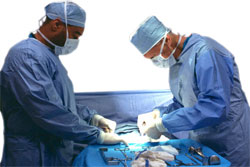- Introduction to obesity
- Overview of obesity treatments
- Lifestyle changes
- Pharmacotherapy
- Surgery for obesity
- Conclusion
Introduction to obesity

Obesity is a serious medical condition and can lead to considerable health consequences including heart disease, diabetes, high blood pressure, high cholesterol, obstructive sleep apnoea and arthritis. Therefore it is very important that you seek appropriate treatment.
Obesity is essentially a disorder of your metabolism and is caused by an imbalance between energy intake and energy expenditure over a long period of time. In other words, you are consuming more calories or energy than you are burning through exercise and daily activities. Treatment of obesity therefore aims to restore this energy balance.
There are numerous different treatment options available which are described briefly below. Further information can be obtained by following the links to each of the treatments. In addition you can view the following video which provides an overview of the different management options.
Overview of obesity treatments
Traditional methods for weight loss include reducing calorie intake, increasing physical activity, and behaviour therapy. However, increasing levels of obesity and associated medical conditions has heightened interest in both pharmacological (drug) and surgical treatments for weight loss. In most cases you will be treated with a combination of therapies. The aim of therapy is to try to restore your normal weight and reduce co-morbidities without causing significant side effects or morbidity. In general, the greater the degree of weight loss achieved, the greater health benefits gained. However, even small amounts of weight loss (of 5-10% of body weight) can significantly improve your health. Therefore you should set realistic goals and be satisfied with even small amounts of weight loss.
Lifestyle changes
Lifestyle modification remains the mainstay of treatment for obesity and is an essential component of all forms of weight loss programs. Lifetime changes in eating and exercise behaviour may be the only treatment that produces long term and sustained reductions in weight. Lifestyle changes can include the following components:
Dietary changes

Meal replacement programs
Recently meal replacement programs have been developed that replace normal meals with prepared meal plans or meal supplements (such as vitamin- and mineral-fortified shakes, soups and bars). These diets operate on the principles of a low calorie diet and induce a mild state of ketosis to produce weight loss. These diets limit your carbohydrate intake so your body switches to other forms of energy, in particular the fat stores in your body. Burning your fat stores eventually leads to weight loss. (Please refer to our metabolism write up for further information). These diets are specially formulated so that they provide a safe level of carbohydrates and continue to supply essential vitamins and minerals.
Physical activity
Increased physical activity is often used in conjunction with diets to increase energy expenditure. Using exercise alone for weight loss is however often unsuccessful. You can try to increase your physical activity by walking places rather than driving and climbing the stairs rather than using the escalator or lift. You should aim to engage in 30 minutes of moderate intensity exercise (such as brisk walking) at least 3-5 days per week. You should try to do activities you enjoy as this will increase the likelihood you will adhere to them in the future. If you are very obese and have difficulty exercising you could try swimming, cycling or walking in water until your fitness level improves. You may be referred to a physiotherapist or exercise physiologists to help you devise an appropriate exercise program.
Behavioural therapy

Lifestyle changes are extremely challenging and you must be highly motivated to achieve success. Most patients will achieve weight loss by the above methods but long-term maintenance of weight loss remains an issue. Approximately 90% of people will regain their weight lost in supervised programs in the next few years. Lifestyle changes however remain the most hopeful treatments for long-term weight loss if you adhere to them correctly. If you are only mildly overweight (i.e. a body mass index (BMI) less than 30), lifestyle treatments alone are often sufficient to achieve weight loss. If however you are obese (BMI greater than 30) lifestyle treatments may be insufficient to achieve satisfactory weight loss and additional treatments such as pharmacotherapy may be necessary to maintain weight loss.
Pharmacotherapy
Several weight loss drugs have been marketed to date which work by either suppressing the appetite (e.g. Sibutramine – Reductil) or reducing absorption of fats (e.g. Orlistat – Xenical). These drugs should always be prescribed by a medical professional. These agents can cause weight loss of up to 10% of body weight. However, following cessation of treatment much of this weight will be regained. In addition many of these drugs can have nasty side effects (such as diarrhoea) and are still being investigated in clinical trials. Some older drugs such as fenfluramine have been withdrawn form the market due to bad side effects on the heart.
In order for medications to really work, they need to be combined with lifestyle modifications such as a low fat diet and regular exercise. Medications for weight loss should only be taken for short periods (up to 3 months) and always be used with caution as they have the potential for abuse. At present they are only indicated if you are morbidly obese, have significant co-morbidities or if you have failed other lifestyle treatments.
Surgery

A variety of surgical procedures have been used which can be broadly classified into restrictive and mal-absorptive procedures. The former includes procedures such as the old fashioned gastroplasty and laparoscopic gastric banding. The latter is the most common procedure performed in Australia because it is safe and reversible. By means of a silicone band around the stomach, gastric banding physically limits the amount of food that can be consumed before you become full. Mal-absorptive procedures (such as gastric bypass) typically involve bypassing a segment of small intestine to reduce the absorption of calories and hence lead to weight loss. Both methods produce similar long term results in terms of weight loss with patients losing approximately 50-70% of their excess weight. However, bypass operations may be more risky and can interfere with absorption of essential vitamins and minerals.
Conclusion
Whilst surgery is becoming increasingly common for the treatment of obesity, diet, exercise and long-term lifestyle changes remain the cornerstone of treatment. Surgery should only be considered if you are morbidly obese with significant weight related health problems. Successful treatment of obesity therefore requires an integrated and multidisciplinary approach with input from a variety of health professionals including dieticians, physicians, physiotherapists, surgeons and psychologists/psychiatrists.
In order to achieve long term weight loss you are required to make lifetime changes in your eating and exercise behaviours. In the future, the government may also be able to help treat the obesity epidemic by altering the environment we live in. Strategies and public health campaigns to produce an environment that supports healthy eating and physical activity throughout the community are needed.
More information
 |
For more information on obesity, health and social issues, and methods of weight loss, as well as some useful tools, see Obesity and Weight Loss. |
References
- About overweight and obesity [online]. Canberra, ACT: Australian Government Department of Health and Ageing; 2005 [cited 9 August 2007]. Available from: URL link
- The Obesity Society: Fast facts [online]. University of Sydney, NSW: Australasian Society for the Study of Obesity; 2005 [cited 9 August 2007]. Available from: URL link
- Flier J, Maratos-Flier E. Chapter 242: Obesity. In: Braunwald E, Fauci AS, Kasper DL, et al (eds). Harrison’s Principles of Internal Medicine (16th edition). New York: McGraw-Hill Publishing; 2006. [Book]
- Hamdorf J. Obesity Management . Osborne Park, WA: Virtual Medical Centre; 2007 [cited 9 August 2007]. Available from: URL link
- Kumar P, Clark M (eds). Clinical Medicine (5th edition). Edinburgh: WB Saunders Company; 2002. [Book]
- Clinical practice guidelines for the management of overweight and obesity in adults [online]. Canberra, ACT: Australian Government Department of Health and Ageing; 18 September 2003 [cited 9 August 2007]. Available from: URL link
- Proietto J, Baur L. Management of obesity. Med J Aust. 2004;180(9):474-80. [Abstract | Full text]
- Wilding J. Science, medicine, and the future: Obesity treatment, BMJ. 1997;315(7114):997-1000. [Abstract | Full text]
Drugs used in this treatment:
All content and media on the HealthEngine Blog is created and published online for informational purposes only. It is not intended to be a substitute for professional medical advice and should not be relied on as health or personal advice. Always seek the guidance of your doctor or other qualified health professional with any questions you may have regarding your health or a medical condition. Never disregard the advice of a medical professional, or delay in seeking it because of something you have read on this Website. If you think you may have a medical emergency, call your doctor, go to the nearest hospital emergency department, or call the emergency services immediately.







